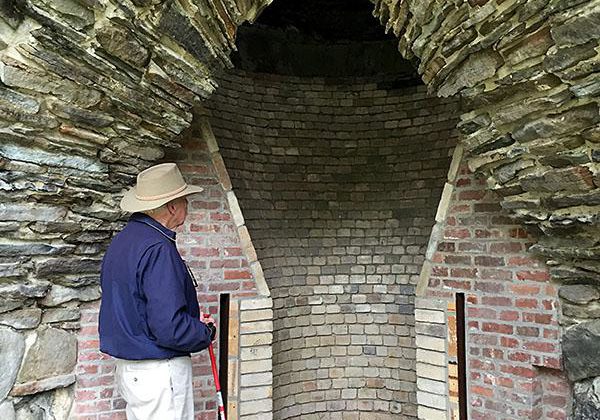Beckley Furnace Stands as a Reminder of Industrial Days in Northwest Corner
Area was rich in iron ore deposits
By Colleen Gundlach
Have you ever hiked Canaan Mountain in the East Canaan area and discovered mounds of beautiful, glassy black rocks and wondered where they originated and why there are so many of them? They are slag—a very unappealing name for a truly lovely rock—and their origin goes back to 1728 when a group of surveyors were sent out from Hartford to determine borderlines for the towns that were soon to be incorporated.
While the surveyors were working in Salisbury, their compasses began acting erratically. The cause, as the surveyors soon discovered, was massive underground iron deposits, and by 1731 they had unearthed what would be the largest and richest deposit of iron ore in northwestern Connecticut. In 1734, Massachusetts native Thomas Lamb realized the possibilities of this ore and began buying land and building forges for smelting ore into wrought iron. Over the next few years, additional forges were built—in Salisbury, East Canaan, Sharon and Kent.
The forges, however, could only produce 400 pounds of iron per day, so blast furnaces needed to be built to accommodate the growing industry. According to Sharon resident Ed Kirby, who is an educator, author, geologic consultant and president of Friends of Beckley Furnace, “With the demand for iron continuing to grow, the Forbes brothers of East Canaan, along with John Hazeltine of Massachusetts and a 23-year-old from Cornwall named Ethan Allen, built the region’s first blast furnace in the Lakeville section of Salisbury in 1762. During the American Revolution, 80 percent of the cannon produced in the colonies were made at the Salisbury furnace.”
Over time, a total of 22 blast furnaces were built in Northern Litchfield County, including Beckley Furnace (also known as East Canaan #2), which still stands today. Beckley Furnace, located along the Blackberry River in East Canaan, was built in 1847 by John Adam Beckley and stood 32 feet in height, but it was extended to 40 feet in 1880 so that that more iron could be produced. The furnace was later purchased by the Barnum Richardson Company. William H. Barnum, one of the owners of the company, was a U.S. Senator from Lime Rock and third cousin once removed to P.T. Barnum of circus fame.
During the heyday of the iron business in this part of the state, cotton gin inventor Eli Whitney obtained a government contract to provide 10,000 muskets in 1798. It’s interesting to note that many of these muskets were constructed in Norfolk at the Connecticut Arms Company from iron produced in the northwest corner iron furnaces. This business was housed in a long stone shop located on the Blackberry River where, according to Theron Crissey’s “History of Norfolk,” the “second largest overshot water wheel in the country” provided the power necessary to produce the muskets and, later, revolvers.
In order to produce iron, the blast furnaces were built of a stack of large stones with ground-level arches. One let the melted iron out and the others provided the air blast from the outside. The arches in the stone hearth of the furnace allowed nozzles, called a tuyere, to carry the blast air in. Next to the furnace was a charging wall, at the same height as the furnace. Workers built a bridge from the wall to the furnace, over which they would wheel the iron ore and lime required to produce the cast iron, and drop it into the furnace. The walls were lined with heat-resistant brick.
The charcoal fire heated the ore in the furnaces to 2,800 degrees Fahrenheit. During this process, the lime, acting as a flux, reduced the iron from the other materials and formed slag, which floated to the top of the molten iron and could be easily separated from it. The resulting silicon dioxide hardened, giving the slag a glass-like, shiny appearance.
Today, on the opposite side of the river from Beckley Furnace is the Iron Trail. As hikers begin their trek, at the bottom of the trail they will find slag remaining from the iron production, piled 70 feet deep over eight acres. Collectors often fill bags full of these beautiful and intriguing rocks, reminders of the hard work of many men who were instrumental in the industrial development of our country, right here in northwestern Connecticut.
Beckley Furnace is located at 140 Lower Road in East Canaan. Since 1946, it has been an affiliated state park, open to the public 365 days a year for visiting, picnicking and hiking. There is a self-guided tour available at all times, but during the summer months between 10 a.m. and 2 p.m., tour guides from the Friends of Beckley Furnace are also on the premises. For more information, write to info@beckleyfurnace.org. To learn more about the history of northwest corner iron, read Ed Kirby’s book, “Echoes of Iron in Connecticut’s Northwest Corner: With a Field Guide to the Iron Heritage Trail.”
Photo of historian Ed Kirby at the Beckley Furnace by Colleen Gundlach.

